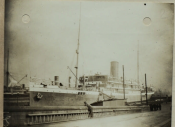
Presidential Library marks Shipbuilder's Day
On 29 June, Russian shipbuilders celebrate their professional holiday. This date is associated with the decree of Tsar Alexei Mikhailovich on the construction of the first Russian warship "Oryol".
Russia is a maritime power, and St. Petersburg is an important centre of shipbuilding. The library's collection contains unique materials, photos and documents about the development of the shipping industry.
This year marks 210 years since the first steamship "Elizabeth", named in honour of the Empress, was launched in 1815 in St. Petersburg at the factory of industrialist Charles Bird. It became a significant event. The steamship "Elizabeth" made its first voyage to Kronstadt. Marine officer Ricord shares his recollections about how it happened: "... I took part in this curious trip. On the 3rd of November at 6.55 a.m. the ship departed from the Berdov factory wharf and sailed down the Neva River... The course of the ship was repeatedly measured... Such a ship moving in pairs appeared for the first time on the Kronstadt roadstead, many spectators were attracted to the merchant harbour for curiosity, in front of which the steamer was now making small trips.... On the way back the waves rose and a strong wind "blew against the bow on the right side", so the steamer had the best chance to "test its merits". The return journey was 5 hours. 22 min.".
In the 1840s, His Imperial Majesty Nicholas I already regularly travelled by steamship to Kronstadt, as evidenced by the list of days of his trips. The files of the Police Department of the Executive Ministry of the Interior for the years 1851-1852 is a document that contains draft rules for private passenger steamships travelling between the capital and its suburbs. Particular attention is paid to passenger safety. In a letter to the Minister of Internal Affairs, the St. Petersburg Military Governor-General's Office suggested that each steamship "should have a book for recording complaints". At the same time, "everyone making a complaint should explain his rank and place of residence", and a passenger's complaint was considered objective only if there were two witnesses.
The huge potential in the commercial use of steamships was obvious. The development of the steamship industry made it possible to conquer the great seas. And in 1856 the Russian shipping company "Russian Society of Shipping and Trade" appeared, which aimed at resumption of cargo and passenger traffic between the ports of the Black, Azov and Mediterranean seas, as well as expansion of foreign trade in the southern part of Russia.
In the electronic reading rooms of the Presidential Library documents on the activities of the Russian Society of Shipping and Trade in different years are available. These are reports and cost estimates, Notes of shareholders with remarks on the reports of the Russian Society of Steamship Industry and Trade (about shortcomings of reports, situation on the lines, measures to avoid losses), Plan of passenger rooms of steamships of the Russian Society of Steamship Industry and Trade, Charters, draft charters and instructions of the Russian Society of Steamship Industry and Trade and others.
The album-prospectus New steamships of the Russian Society of Shipping and Trade (1913) contains photos of steamships of the XX century, their interiors and information about the advantages of using this type of sea transport. The album-prospectus says: "Man conquered the air, airships and aeroplanes appeared, dreadnought giants appeared (warships of the beginning of the XX century. - Ed. note), commercial steamships appeared with such tonnage, which surpass even military vessels; these floating cities began to be furnished, besides the last word of technology and the latest improvements, with mad luxury...".
In response to the "demands of the time", the Russian Steamship and Trading Society built four steamships in England. They were named in honour of Russian emperors: "Emperor Peter the Great", "Empress Catherine II", "Emperor Nicholas I", "Emperor Alexander III". They were the first in their size - "over 10,000 tonnes each", had the most modern equipment, luxurious rooms for passengers, and those who travelled in the third class were not forgotten. All steamships were equipped with "the latest ventilating, disinfecting and cargo preserving devices". Steamships went to the ports of the Black and Mediterranean seas: they made direct voyages "between Odessa and Alexandria, through Constantinople, Piraeus and Smyrna, leaving Odessa on Thursdays, coordinating their departure and arrival with the schedule of Odessa trains".
In the electronic reading rooms of the library is presented an interesting document from 1913 - Letter and telegram of Mikhail Gayman to the chairman of the Russian Society of Shipping and Trade Anatoly Evgrafovich Molchanov about the launching of the steamship "Emperor Peter the Great" (with an attachment of his photo). Also available in the fund is a picture of the steamer "Empress Catherine II" and its interiors.
More interesting materials about the development of shipbuilding in Russia are available on the Presidential Library's portal, in the collection Peter the Great (1672-1725), in the section Fleet.













